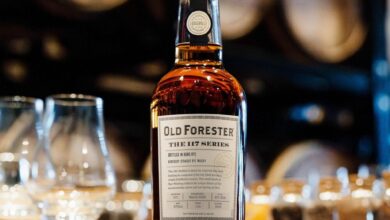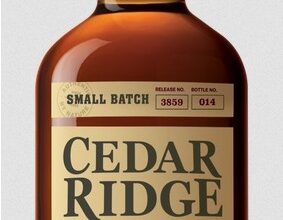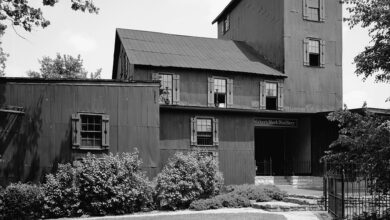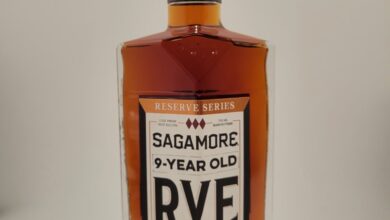Choosing A Good Starter Rye
By Richard Thomas
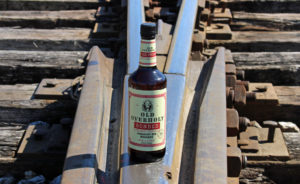
(Credit: Richard Thomas)
Having spent a good deal of time asking people with what bottle they were first introduced to whiskey, I have only heard a rye whiskey mentioned once. Various bourbons, Scotch and Irish whiskies have been cited dozens upon dozens of times, and even Canadian whiskies appear in the recollections of Boomers, but only once for rye whiskey.
My suspicion is the last time one would find many Americans who got started with whiskey by sipping a rye would have been before Prohibition. Many factors go into explaining how that came about, but nowadays rye is just not how most people get started with whiskey, excepting possibly using rye in a cocktail. Compounding that is how some folks are genetically predisposed to dislike bitter and spicy flavors. Yet since the Rye Crunch of 2011-12, rye whiskey has been the fastest growing and most vibrant of the many long disused sectors of American whiskey. Some would say that momentum has reached maturity and slowed down, but it was only this year when Suntory Global Spirits began to give its disued Old Overholt, the classic brand of rye whiskey, the attention it deserves.
So, rye whiskey remains a branch of American whiskeydom that many drinkers are unfamiliar with, and how to introduce friends and family to it is not obvious. Indeed, just as smoky Scotch has the potential to permanently turn off some folks, boldly spicy rye could do the same for neophytes. Thankfully, the dominant branch of rye whiskey today is well-suited to the job of providing a starter bottle: Kentucky style rye whiskey.
Rye Done Bluegrass Style

(Credit: S.D. Peters)
In keeping with American whiskey law, the major stipulation for a rye whiskey is that it be fermented from a mash of 51% rye grain or greater. Rye was originally associated most closely with Pennsylvania and Maryland, not Kentucky, but three trends that dominated the industry in the mid-20th Century consolidated rye whiskey production in the Bluegrass. First, many whiskey brands were traded between liquor conglomerates as if they were Cracker Jack toys. This detached brands that had been started in the Keystone or the Old Line State from the distillery that originally made them. Second was the prevailing era of industrial consolidation, which was widespread in the US during the post-war period. Third was that the distilling industry of Pennsylvania and Maryland never really recovered from the tribulations of the early 20th Century, such as Prohibition, so each decade saw fewer and fewer active distillers in those states.
Eventually, these factors consolidated rye production into Kentucky distilleries, all of which had excess production capacity as the Great Whiskey Bust of the 1970s settled upon and smothered the industry. For example, when Jimmy Russell became a Master Distiller in 1964, his factory was not called the Wild Turkey Distillery or even the Austin Nichols Distillery. Those names would not come to the facility until 1971, and they brought with them rye whiskey. Rye had not been made there before, and Jimmy Russell supposedly did not like it and did not want to make it, but he had his marching orders. The result is the Wild Turkey 101 so beloved by rye fans today.
Similarly, Jim Beam acquired Old Overholt as part of a deal with National Distillers in 1987, along with Old Crow and Old Granddad. Heaven Hill picked up the Rittenhouse brand in 1993, after its ownership went bankrupt.
Some Kentucky distillers were already making rye when they acquired these brands and some only started because of it, but they all followed a similar approach, which has become the Kentucky style rye. This is defined by having a minimal amount of rye in the mash, usually between 51 and 55%. The style could also be called “high corn” rye, because the relatively low rye content opens the door for much more corn than, say, a Maryland distiller would have used.
In the Bluegrass, bourbon makers and had well-defined production processes for making bourbon. Some bourbons are known for having a high-rye content, so that served as a model for making a rye whiskey with Moreover, rye is a notoriously sticky grain in the mash, and their existing equipment was not well-suited to making high. So, they all chose to make a rye whiskey that was as close to bourbon as possible. There are exceptions, such as the Old Maysville Club made by Old Pogue, but these are recent products of the 21st Century.
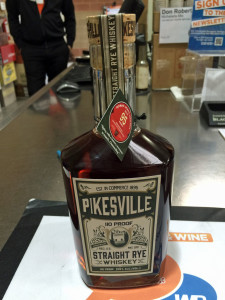
(Credit: John Rayls)
That style is a huge boon for a starter rye, since it is only one step removed from the bourbon your novice is likely familiar with. That becomes doubly true if they are familiar with high rye bourbons, such as Basil Hayden. Even if the novice is not already familiar with bourbon, that the style leans heavily towards the sweet, corn- and new oak-derived of bourbon helps work around the potential a boldly spicy rye has to permanently turn people off. Kentucky style rye is drier and spicier than most bourbon whiskeys, but not nearly so much so as Pennsylvania ryes.
Starter Ryes For Every Budget
Mass Market Whiskeys
Old Forester Rye
Old Overholt Bottled in Bond
Rittenhouse Bottled in Bond Rye
Sazerac 6 Year Old Rye
Middle Market, Premium Whiskeys
Knob Creek 7 Year Old Rye
Pikesville Rye
Wild Turkey 101 Rye
Woodford Reserve Rye

